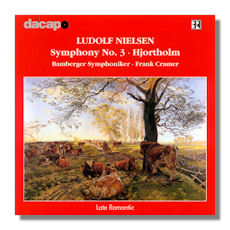
The Internet's Premier Classical Music Source
Related Links
- Latest Reviews
- More Reviews
-
By Composer
-
Collections
DVD & Blu-ray
Books
Concert Reviews
Articles/Interviews
Software
Audio
Search Amazon
Recommended Links
Site News
 CD Review
CD Review
Ludolf Nielsen

Symphony #3
- Symphony #3
- Hjortholm
Bamberg Symphony Orchestra/Frank Cramer
Marco Polo dacapo 8.224098 DDD 67:20
No relation to Carl, fellow Dane Ludolf Nielsen was nevertheless his namesake's almost exact contemporary. (Ludolf's dates are 1876-1939, and Carl's are 1865-1931.) Like Carl, Ludolf was a country boy. At the age of 16 he went to Copenhagen and eventually won a scholarship to the Royal Academy of Music. While he Copenhagen, he played the viola with the Tivoli Orchestra (which he eventually conducted), and soon heard the premières of his first orchestral works. After additional studies in Leipzig, Nielsen returned to Denmark and became increasingly active as a conductor and as a composer. Later, he became active in composing for the nascent national radio. His oeuvre is comprised mostly of orchestral music (three symphonies, orchestral suites, theater scores) and songs.
Encouraged by the international success of his Second Symphony, Nielsen began his Third Symphony in 1911-12, completed it in 1913, and attended its première the following year. This time the outcome was somewhat different; Nielsen was unable to interest foreign musicians in playing it, and it has not been performed, even in Denmark, since 1943. The new symphony was not considered to be inferior, but Nielsen was implicitly criticized for not having made any stylistic changes in the interim. As a result, Nielsen never completed another symphony, although he did sketch two others based on Biblical themes.
The Third Symphony is based on a Mahlerian counterpoint between life's joy and its attendant sorrow; one cannot exist without the other. While its goals and heavy scoring are similar to Mahler's works, it is a relatively old-fashioned work. If anything, there are passing hints of Bruckner, and maybe even Bax. The first movement introduces the symphony's philosophical argument right away; the main theme, introduced by the English horn in the introduction, seems to be able to take on the characteristics of either emotional state, depending on Nielsen's setting. It bears a resemblance to the Rodgers and Kart tune "My Heart Stood Still." The second movement is a seascape, or specifically, a youthful scherzo that Nielsen described as a depiction of the life of mermaids and mermen; how this relates to the overall theme is not made clear. In the third movement, which Nielsen called a "summer evening idyll," Nielsen is at his late Romantic best painting a landscape that is at first peaceful (but melancholy), then shot with conflict and loss in a stormy middle section. The finale, the symphony's longest movement, takes the work full circle; it ends with the same gentle pastoral joy, but not before both heroic and religious manifestations of the ever-transformed "My Heart Stood Still" theme are brought to a crisis by an orchestral attack. The message then, seems to be that although the individual man passes away, renewal of life – and of the joy of life – always occurs.
Hjortholm was completed in 1923, and it too received a cool reception, even at home. In fact, it received only three performances prior to this CD. Hjortholm was a castle that stood in Denmark during the Middle Ages, but it was destroyed in 1535 when Denmark became a Protestant country. In the work's outer sections, Nielsen uses dark, misty scoring and uncertain tonality to indicate the castle's incorporeal presence. Like time-travel, the writing at Hjortholm's center shows the castle and its inhabitants as they were during the Middle Ages. The music is elegiac and noble, fit for the castle's lordly people, but hinting at their violent disappearance.
There are first recordings. The Bamberg Symphony Orchestra plays well enough, although the strings are thin and the brass lacks refinement. Cramer now has recorded all three of Nielsen's symphonies, and he is sympathetic to their appealing late Romantic gush. The sound is a little thick, but, to be honest, so is Nielsen's scoring.
Copyright © 2000, Raymond Tuttle


















